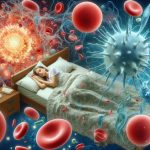HIV is a disease that brings woe to those that have it and scares those that do not.
![Will There Ever Be A Cure For HIV? [Steps Being Taken]](https://alphanutrition.com/wp-content/uploads/2022/08/Will-There-Ever-Be-A-Cure-For-HIV-Steps-Being-Taken.jpg)
It is a terrible condition that attacks the immune system over a very long period of time and ever since it came to public prominence in the 1980s, thousands of healthcare professionals have struggled to deal with it.
With such a well known and dangerous condition existing in our world, you would have thought that many would have tried to find a cure for it, and many have tried.
But the attempts in the past have not been met with overall success, instead only getting a partial success of what they wanted.
So, will there ever be a cure for HIV? How close are we to having one?
In this article, we will look at the steps being taken to cure HIV and whether we are any closer to curing the condition.
The Problems
There are many problems with even treating HIV, let alone curing it.
It is an incredibly virulent and potent virus that travels very quickly through bodily fluids, and there are a lot of unjust stigmas present around the people who have the virus, making it quite hard to correlate a discernible pattern of where treatment is needed.
Due to the fact that the people most at risk of infection reside in the continent of Africa, it can be quite hard for researchers not from that region to organize a medical research expedition without additional funding.
The people with the condition also need to give informed consent before any clinical trials can be performed on them, otherwise you risk a breach of ethics.
Another issue is that the disease has a vast effect on the body.
It breaks apart the immune system cells and causes co-infections more easily from other diseases.
As such, treating the HIV itself without also treating other infections is impossible, and you would need to work through whether your treatment is curing the HIV condition or the coinfection that it is causing.
HIV is also a complex virus, and it has a surprising high genetic variability between the two types of virus and their subtypes as well.
Just between HIV 1 and 2 there is a genetic variation of 55%, which means any vaccine that would stop HIV 1 would probably not stop HIV 2.
There are even quite large genetic variations between subtypes of the same virus, with some subtypes of HIV 1 having a genetic variation of up to 35%.
This complexity also extends to evolution and mutation within the virus itself.
This evolution has led to something called a latent reservoir within the virus.
These are cells of the virus that hide within the body during the early stages of infection.
They can hide from the cells, the immune system, and antiretroviral therapy that is used to treat HIV.
When the treatment is stopped for HIV, these cells re-emerge, restarting the infection.
Finally, any treatment or cure for the virus would have to take into account immune exhaustion.
HIV attacks the immune system, and the immune system’s slow decline over many years will take its toll.
Any cure that is thought of will have to take into account immune exhaustion as a side effect, and may need to be functional on its own without immune help.
Is There Any Hope Of A Cure?
![Will There Ever Be A Cure For HIV? [Steps Being Taken]](https://alphanutrition.com/wp-content/uploads/2022/08/Will-There-Ever-Be-A-Cure-For-HIV-Steps-Being-Taken-2.jpg)
Potential In Stem Cell Gene Therapy
Although there are problems with a cure, there is a lot of hope out there as well.
So far, there have been two people in history who have been treated that managed to have their HIV go into remission.
These are the Berlin patient (Timothy Brown) and the London patient (Adam Castillejo).
Brown and Castillejo were both men who had cancer and when they had chemotherapy, their immune system was basically wiped out.
When doctors looked for stem cell donors to give the men a transplant, they found that they were a match for a lot of different people.
This was unusual, as most people struggle to find a single match, but also could prove useful for an HIV cure, as they decided to use a donor with the genetic mutation CCR5-delta 32.
This mutation basically gives HIV immunity to the person with it.
A couple of months after Brown’s transplant, they checked his blood for HIV and found none.
This continued to be the case until his death 13 years later.
This has and continues to be the case for Castillejo, though whether or not this will continue remains to be seen.
While this is a step in the right direction, it is not a good idea for anyone without cancer.
These two men basically had no options left, and the procedure was risky.
Their immune system was completely gone through chemotherapy and they and the doctors took a chance to restart the immune system with different cells, which would not be the case for someone who hasn’t undergone chemotherapy.
However, based on these cases, a new approach has been made using stem cell gene therapy with genetically engineered hematopoietic stem cells that have anti-HIV genes in them that can self-renew and multiply in the body.
The cure from this method is a long way off, but it is predicted.
Broadly Neutralizing Antibodies
These are a rare type of antibody that is actually able to target HIV variants.
They were first discovered in people who show no symptoms of HIV (see also ‘What Are The Main Symptoms Of HIV?’) and can suppress the viral replication of it, but do have the virus.
From these antibodies, researchers have been trying to create a vaccine to eliminate the virus once and for all, but this is a very new area and the trials have only begun in the last few years.
Conclusion
Currently, there is no cure for HIV, but that doesn’t mean that there won’t be one in the future.
There are many promising leads and ideas surrounding how to cure HIV and even though progress is slow, it has been shown to be working. It just needs time.
- Understanding Male Reproductive Health: A Complete Guide - February 2, 2025
- Simple Healthy Skin Habits for Radiant Skin - December 6, 2024
- Unlocking the Connection Between Nutrition and Mental Health - December 3, 2024








